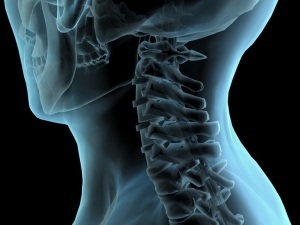Signs of cervical osteochondrosis in a strong manifestation usually surprise the patient, although the prerequisites for the disease are observed long before the onset of the main symptoms and are the result of degenerative changes in the structure of the vertebrae. The nerve roots of the C5, C6 and C7 levels (cervical spine) are most commonly affected.
Clinical manifestations
Symptoms of cervical osteochondrosis are divided into radicular and reflex.
Reflex Syndrome

Lumbago is characteristic of reflex symptoms. Its main characteristic is the sudden appearance of an uncomfortable movement, jerk or long head in one position. Lumbago of the cervical spine literally knocks a person out of the rut, movements are restricted, the patient takes a forced position due to severe pain.
Frequent complaints from patients:
- constricting headache radiating to the temples or eyeballs;
- decreased visual acuity in front of the eyes, as if "everything is floating";
- possible pressure increase.
Vertebral artery syndrome occurs when the nerve plexus is irritated, which is often misdiagnosed as a cerebrovascular accident. Manifestations of cervical osteochondrosis with a similar syndrome are more common dizziness, which occurs with a sharp turn of the head, almost always accompanied by an uncomfortable feeling of nausea and even vomiting.
It is important to rule out cerebrovascular accidents in the diagnosis, since the treatment of osteochondrosis is fundamentally different from the treatment of diseases of the vascular system.
Having a cardiac symptom in the clinic for reflex syndromes in cervical osteochondrosis, the patient is characterized by sensations similar to an attack of angina pectoris. However, difficulties in accurately diagnosing the disease are usually not observed, since the cardiac symptom is accompanied by a number of symptoms that are characteristic of osteochondrosis of the spine.
Radicular Syndrome
Signs of cervical osteochondrosis in radicular syndrome are directly related to the "number" of the compressed nerve.
Symptoms, sensory and motor changes depend on which nerve root is affected:
- C1- There is a violation of sensitivity in the occipital area.
- C2- the patient feels pain in the parietal and occipital areas;
- C3- pain occurs in the half of the neck where the injury occurred. Symptoms: decreased sensitivity, dysfunction and touch of the tongue, speech disorders;
- C4- there is pain in the shoulder-shoulder blade area, impaired sensitivity, there may be pain in the heart and liver;
- C5- The patient does not feel the shoulder on its outer surface well and is concerned about pain in this area.
- C6- pain in osteochondrosis at the level of the 6th vertebra extends to the forearm, shoulder blade, radial surface and “sink” down to the thumb of the hand;
- C7- the pain "spreads" from the neck to the shoulder blade, runs along the back of the shoulder and forearm, goes to 2-4 fingers of the hand, the sensitivity in this area worsens;
- C8- The pain is localized from the neck to the shoulder and on to the little finger.
Inseparable pathological link

VSD and cervical osteochondrosis are closely related, and vegetative-vascular dystonia can manifest itself as a result of damage to the cartilage of the cervical joint, which loosens the human nervous system. Dystonia and osteochondrosis detected at the same time can be a common condition, or VSD occurs for common reasons.
Osteochondrosis is one of the factors that causes VSD, but the second does not need to follow the first.
Vegetovascular dystonia often manifests itself in various types of osteochondrosis, especially in diseases of the cervical spine. But it can also manifest itself as a result of an injury, compression of the nerves in the cervical spine occurs, blood flow deteriorates, and pressure in the skull increases.
Diagnostic error
VSD, osteochondrosis and chest pain are basically treated differently. Expensive (and often unnecessary) tests only reveal problems in the cervicothoracic area and disturbances in the work of the blood vessels. In this case, the treatment often remains the same - heart complexes, vitamins, antidepressants. Chiropractors eliminate pain, put the patient in an optimistic mood, but panic attacks, stress, and fatigue go nowhere.
More and more people are victims of improper therapy, panic attacks (or a bout of VSD) are becoming almost the norm for them, yet many patients prefer self-medication or visiting "doctors" whose activities are not aimed at getting rid of the disease, but only for self-enrichment.
Groups of characteristic manifestations
The main clinical signs of cervical osteochondrosis can be divided into several groups:

- first.Neurological symptoms arise as a result of complications from cervical osteochondrosis and from direct pressure on the nerve roots, nerve plexus;
- second.The symptoms are expressed in direct exposure to the spinal cord.
- third party.Symptoms occur in the brain and affect its vessels, structures, membranes and trunk.
Each of the groups listed has its own clinical signs and patterns of manifestation, but there is a commonality of symptoms that makes it possible to make a correct diagnosis.
Symptoms of osteochondrosis of the cervical vertebrae often occur as a neurological complication, the characteristic feature of which is pain in the shoulder joint. This pathology is called "periarthritis of the scapula".
Special features of spinal cord compression in the cervical area are volumetric lesions in the tissue and a strong decrease in important functions. Skin and muscle sensitivity is impaired, paresis develops, and in complex pathological cases, paralysis.
That is why it is important to consult a specialist, to carry out the necessary diagnostic measures and to undergo treatment at the first suspicion of cervical osteochondrosis. Remember that the pathology detected in time will be eliminated quickly and without consequences.





































